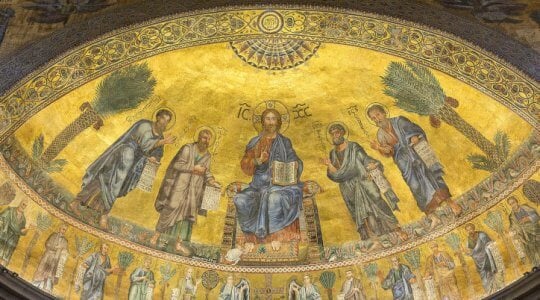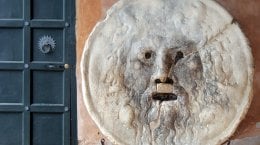Official Reseller Rome and Vatican – Jubilee 2025
The Basilica of St. Paul Outside the Walls
The Basilica of St. Paul Outside the Walls is one of the most important papal basilicas in Rome, the second in size after St. Peter.
A Byzantine structure that was declared a World Heritage Site by UNESCO, which contains works of important artistic value.


In 313 the promulgation of the edict of the Emperor Constantine put an end to the persecution of the Christians and built a church in the place where St. Paul was beheaded, between A.D. 65 and 67, at the time of Nero, while it was consecrated in 324 by Pope Sylvester.
The Basilica has been the subject of various renovations over time. The most important one took place between 384 and 395, when a large area with five aisles that opened onto a quadrangle was built.
Later the fortification walls were erected, to protect it from the invasions of the 9th century, as well as the bell tower, the Byzantine door composed of panels engraved in silver foil, the mosaics of the facade of Peter Cavallini. Between 1208 and 1235 the cloister of the Vassaletto, the candlestick for the Easter candle and several other artistic works were built.
In 1725, the Chapel of the Crucifix to include the “Miraculous Crucifix ” was built in polychrome wood.
In 1823 a fire destroyed the basilica which was rebuilt in the following years using the elements saved from the flames, including the transept, the apse and the cloister, to be consecrated in 1840, by Pope Gregory XVI. Later it was subjected to various embellishments and modifications, such as the construction of the portico with the 150 columns.
Exterior of the Basilica
The basilica is located in a courtyard with a four-sided portico, with 150 columns, from which one can admire the nineteenth-century golden mosaics made by Luigi Poletti, which cover the facade of the basilica and which offers a truly impressive scenic effect at sunset. The mosaics are characterized by their depictions represented by the Prophets, the Mystic Lamb, twelve lambs that symbolize the apostles and Christ between Peter and Paul. A large statue of Saint Paul stands in the center of the garden.
Interior of the Basilica
The basilica is accessed by means of a colossal bronze door, a Latin cross plan, divided into five naves, separated by monolithic columns of Montorfano granite, with walls and floors that are covered with polychrome marbles with geometric patterns. Along the two external lateral naves, the transept and the central nave are placed with large round arched windows, in the upper part where there are the golden background rounds that houses the portraits of all the Popes, from St. Peter to Pope Francis. Above the central nave some the mosaic medallions hold paintings depicting episodes from the life of St. Paul.
The Arch of Triumph decorated with mosaics from the 5th century does not go unnoticed in the middle nave. The semi-circular apse is very picturesque, in the center there is the chair and the apse decorated with mosaics made by Venetian craftsmen.
The transept separated from the central nave by the arch of Galla Placidia, is decorated with polychrome marble and Corinthian pilasters, with frescoes and large alabaster windows at the top of the walls. Furthermore, it has two altars in malachite, one dedicated to the Madonna and one to St. Paul. Four chapels are located on the transept. More specifically, that of Santo Stefano, of the Santissimo Sacramento, in which we see the statue of Saint Brigid while on the altar you can see a wooden crucifix, of St. Lorenzo and St. Benedetto.
Below the main nave there is the Confession, the tomb of the Apostle Saint Paul and, at the back, the central altar, above which is the Gothic ciborium and the apse with its majestic mosaic.
The ciborium is a marble aedicule supported by Corinthian columns, with pointed arches at the base and some recess in the corners, that contains the statues of Saint Paul, Saint Peter, Saint Benedict and Saint Timothy. Near the ciborium the candlestick for the Paschal Cero, a 6-meter honorary column, decorated with Romanesque-style bas-reliefs inspired by the decorative elements of the sarcophagi and stories from the New Testament. Regarding the tomb of St Paul, it consists of a marble slab, made up of various pieces and with the inscription “Paulo Apostolo Mart”, placed on a sarcophagus and which can be seen through a window placed on the other papal altar. Among the relics of the saint, there is also a shrine containing his chains.
In the basilica there is a space in which architectural findings from the first Basilica are exhibited, including the sarcophagus of Peter Leone, which depicts the challenge and torture of Marsyas. In the sacristy, there is the chapel of the Relics, which is located where various relics are kept, such as the gilded silver wood and rock crystal of the Holy Cross or a portion of the veil of the Most Holy Virgin.
After visiting the basilica, which is not far from other important attractions of the capital, you can easily reach the Circus Maximus, the Bocca della Verità, Trastevere area and continue to discover the secrets of the eternal city.
Check the stops of the Open Top Bus Vatican & Rome on the map in order to find the closest stop to the attraction you are interested in visiting;
Alternatively, consult https://www.google.com/maps for information on public transport.
Remember: with Omnia 72h you have access to all means of public transport of Rome.
Piramide



